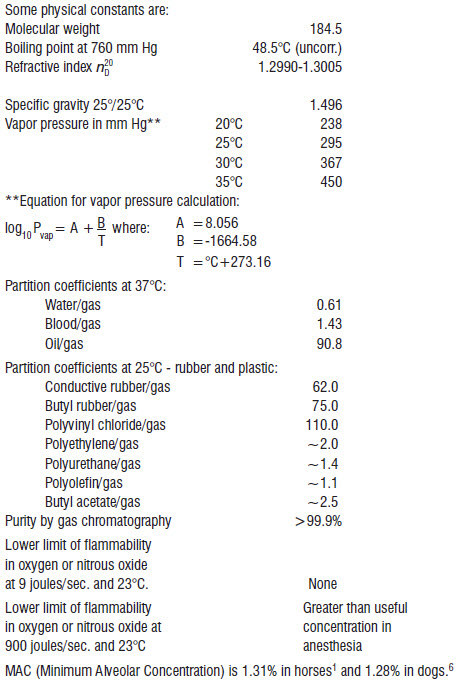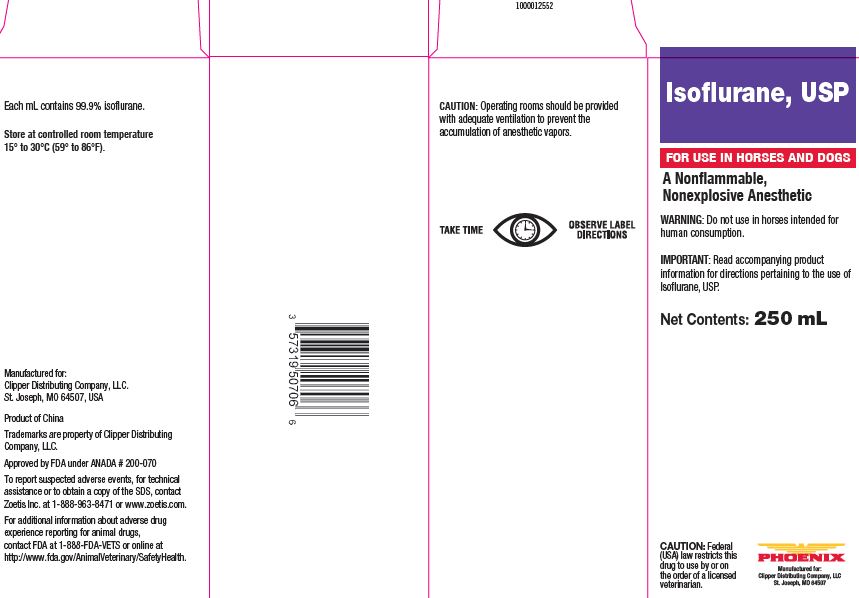ISOFLO- isoflurane inhalant
IsoFlo by
Drug Labeling and Warnings
IsoFlo by is a Animal medication manufactured, distributed, or labeled by Zoetis Inc., AbbVie Inc., Aesica Queenborough Limited. Drug facts, warnings, and ingredients follow.
Drug Details [pdf]
- SPL UNCLASSIFIED SECTION
-
DESCRIPTION
IsoFlo (isoflurane, USP) is a nonflammable, nonexplosive general inhalation anesthetic agent. Its chemical name is 1-chloro-2,2,2-trifluoroethyl difluoromethyl ether, and its structural formula is:

Each mL contains 99.9% isoflurane.

Isoflurane is a clear, colorless, stable liquid containing no additives or chemical stabilizers. Isoflurane has a mildly pungent, musty, ethereal odor. Samples stored in indirect sunlight in clear, colorless glass for five years, as well as samples directly exposed for 30 hours to a 2 amp, 115 volt, 60 cycle long wave U.V. light were unchanged in composition as determined by gas chromatography. Isoflurane in one normal sodium methoxide-methanol solution, a strong base, for over six months consumed essentially no alkali, indicative of strong base stability. Isoflurane does not decompose in the presence of soda lime (at normal operating temperatures) and does not attack aluminum, tin, brass, iron or copper.
-
CLINICAL PHARMACOLOGY
Isoflurane, USP is an inhalation anesthetic. Induction and recovery from anesthesia with isoflurane are rapid.2,5 The level of anesthesia may be changed rapidly with isoflurane. Isoflurane is a profound respiratory depressant. RESPIRATION MUST BE MONITORED CLOSELY IN THE HORSE AND DOG AND SUPPORTED WHEN NECESSARY. As anesthetic dose is increased, both tidal volume and respiratory rate decrease.3,6 This depression is partially reversed by surgical stimulation, even at deeper levels of anesthesia.
Blood pressure decreases with induction of anesthesia but returns toward normal with surgical stimulation. Progressive increases in depth of anesthesia produce corresponding decreases in blood pressure; however, heart rhythm is stable and cardiac output is maintained with controlled ventilation and normal PaCO2 despite increasing depth of anesthesia. The hypercapnia which attends spontaneous ventilation during isofluraneanesthesia increases heart rate and raises cardiac output above levels observed with controlled ventilation.3 Isoflurane does not sensitize the myocardium to exogenously administered epinephrine in the dog.
Muscle relaxation may be adequate for intra-abdominal operations at normal levels of anesthesia. However, if muscle relaxants are used to achieve greater relaxation, it should be noted that: ALL COMMONLY USED MUSCLE RELAXANTS ARE MARKEDLY POTENTIATED WITH ISOFLURANE, THE EFFECT BEING MOST PROFOUND WITH THE NONDEPOLARIZING TYPE. Neostigmine reverses he effect of nondepolarizing muscle relaxants in the presence of isoflurane but does not reverse the direct neuromuscular depression of isoflurane.
- INDICATIONS
- CONTRAINDICATIONS
-
WARNINGS
Increasing depth of anesthesia with Isoflurane, USP may increase hypotension and respiratory depression. The electroencephalographic pattern associated with deep anesthesia is characterized by burst suppression, spiking and isoelectric periods.4
Since levels of anesthesia may be altered easily and rapidly, only vaporizers producing predictable percentage concentrations of isoflurane should be used (see DOSAGE AND ADMINISTRATION ).
The action of nondepolarizing relaxants is augmented by isoflurane. Less than the usual amounts of these drugs should be used. If the usual amounts of nondepolarizing relaxants are given, the time for recovery from myoneural blockade will be longer in the presence of isoflurane than in the presence of other commonly used anesthetics.
WARNING: Do not use in horses intended for human consumption.
-
PRECAUTIONS
Isoflurane, USP like some other inhalational anesthetics, can react with desiccated carbon dioxide (CO2) absorbents to produce carbon monoxide which may result in elevated carboxyhemoglobin levels in some patients. Case reports suggest that barium hydroxide lime and soda lime become desiccated when fresh gases are passed through the CO2 absorber canister at high flow rates over many hours or days. When a clinician suspects that CO2 absorbent may be desiccated, it should be replaced before the administration of Isoflurane, USP.
Usage in Pregnancy: Reproduction studies have been performed in mice and rats with no evidence of fetal malformation attributable to Isoflurane, USP. Adequate data concerning the safe use of isoflurane in pregnant and breeding horses and dogs have not been obtained.
-
ADVERSE REACTIONS
Hypotension, respiratory depression and arrhythmias have been reported. To report suspected adverse events, for technical assistance or to obtain a copy of the SDS, contact Zoetis Inc. at 1-888-963-8471 or www.zoetis.com.
For additional information about adverse drug experience reporting for animal drugs, contact FDA at 1-888-FDA-VETS or online at http://www.fda.gov/AnimalVeterinary/SafetyHealth. - OVERDOSAGE
-
DOSAGE AND ADMINISTRATION
Caution: Operating rooms should be provided with adequate ventilation to prevent the accumulation of anesthetic vapors.
Premedication: A premedication regimen, which may be employed depending upon the patient status, to avert excitement during induction, might include an anticholinergic, a tranquilizer, a muscle relaxant and a short-acting barbiturate.
Inspired Concentration: The delivered concentration of Isoflurane, USP should be known. Isoflurane may be vaporized using a flow-through vaporizer specifically calibrated for isoflurane. Vaporizers delivering a saturated vapor which then is diluted (e.g. Verni-trol® vaporizer) also may be used. The delivered concentration from such a vaporizer may be calculated using the formula:
% isoflurane = 100 PVFV / FT(PA-PV)
Where: PA = Pressure of atmosphere
PV = Vapor pressure of isoflurane
FV = Flow of gas through vaporizer (mL/min)
FT = Total gas flow used (mL/min)Isoflurane contains no stabilizer. Nothing in the drug product alters calibration or operation of these vaporizers.
Induction:
Horses: Inspired concentrations of 3.0 to 5.0% isoflurane alone with oxygen following a barbiturate anesthetic induction are usually employed to induce surgical anesthesia in the horse.
Dogs: Inspired concentrations of 2.0 to 2.5% isoflurane alone with oxygen following a barbiturate anesthetic induction are usually employed to induce surgical anesthesia in the dog.
These concentrations can be expected to produce surgical anesthesia in 5 to 10 minutes.
Maintenance: The concentration of vapor necessary to maintain anesthesia is much less than that required to induce it.
Horses: Surgical levels of anesthesia in the horse may be sustained with a 1.5 to 1.8% concentration of isoflurane in oxygen.
Dogs: Surgical levels of anesthesia in the dog may be sustained with a 1.5 to 1.8% concentration of isoflurane in oxygen.
The level of blood pressure during maintenance is an inverse function of isoflurane concentration in the absence of other complicating problems. Excessive decreases, unless related to hypovolemia, may be due to depth of anesthesia and in such instances may be corrected by lightening the level of anesthesia.
Recovery from isoflurane anesthesia is typically uneventful.2
-
HOW SUPPLIED
Isoflurane, USP is packaged in 100 mL and 250 mL amber-colored bottles.
Storage:Store at controlled room temperature 15° to 30°C (59° to 86°F).
References:
1. Steffey, E.P., Howland, D. Jr., Giri, S. and Eger, E.l. II.: Enflurane, Halothane and Isoflurane
Potency in Horses.
Am. J. Vet. Res. 38(7): 1037-1039, 1977.
2. Auer, J.A., Garner, H.E., Amend, J.F., Hutcheson, D.P. and Salem, C.A.: Recovery from
Anesthesia in Ponies: A Comparative Study of the Effects of Isoflurane, Enflurane,
Methoxyflurane and Halothane. Equine Vet. J. 10(1): 18-23, 1978.
3. Steffey, E.P. and Howland, D. Jr.: Comparison of Circulatory and Respiratory Effects of
Isoflurane and Halothane Anesthesia in Horses.
Am. J. Vet. Res. 41(5): 821-825, 1980.
4. Auer, J.A., Amend, J.F., Garner, H.E., Hutcheson, D.P. and Salem, C.A.:
Electroencephalographic Responses During Volatile Anesthesia in Domestic Ponies: A
Comparative Study of Isoflurane, Enflurane, Methoxyflurane and Halothane.
Equine Practice 3: 130-134, 1979.
5. Klide A.M.: Cardiopulmonary Effects of Enflurane and Isoflurane in the Dog.
Am. J. Vet. Res., Vol. 37, No. 2: 127-131, 1976.
6. Steffey, E.P. and Howland, D. Jr.: Isoflurane Potency in the Dog and Cat.
Am. J. Vet. Res., Vol. 38, No. 11: 1833-1836, 1977.Manufactured for:
Clipper Distributing Company, LLC
St. Joseph, MO 64507, USAProduct of China
Approved by FDA under ANADA # 200-070
Distributed Exclusively By:
Clipper Distributing Company, LLC
St. Joseph, MO 64507, USA
Revised: January 2019
-
PRINCIPAL DISPLAY PANEL
Isoflurane, USP
For Use in Horses and Dogs
A Nonflammable, Nonexplosive, Anesthetic
WARNING: Do not use in horses intended for human consumption.
IMPORTANT: Read accompanying product information for directions pertaining to the use of Isoflurane, USP.
Net Contents: 250 mL
CAUTION: Operating rooms should be provided with adequate ventilation to prevent the accumulation of anesthetic vapors.
TAKE TIME OBSERVE LABEL DIRECTIONS.
Each mL contains 99.9% isoflurane. Store at controlled room temperature 15° to 30°C (59° to 86°F).

-
INGREDIENTS AND APPEARANCE
ISOFLO
isoflurane inhalantProduct Information Product Type PRESCRIPTION ANIMAL DRUG Item Code (Source) NDC: 54771-5260 Route of Administration RESPIRATORY (INHALATION) Active Ingredient/Active Moiety Ingredient Name Basis of Strength Strength ISOFLURANE (UNII: CYS9AKD70P) (ISOFLURANE - UNII:CYS9AKD70P) ISOFLURANE 1 mL in 1 mL Packaging # Item Code Package Description Marketing Start Date Marketing End Date 1 NDC: 54771-5260-5 1 in 1 CARTON 1 250 mL in 1 BOTTLE Marketing Information Marketing Category Application Number or Monograph Citation Marketing Start Date Marketing End Date ANADA ANADA200070 03/30/1993 Labeler - Zoetis Inc. (828851555) Establishment Name Address ID/FEI Business Operations AbbVie Inc. 078458370 MANUFACTURE Establishment Name Address ID/FEI Business Operations Aesica Queenborough Limited 218784074 API MANUFACTURE, MANUFACTURE
Trademark Results [IsoFlo]
Mark Image Registration | Serial | Company Trademark Application Date |
|---|---|
 ISOFLO 86277425 4804993 Live/Registered |
TATE ACCESS FLOORS, INC. 2014-05-09 |
 ISOFLO 76131608 2640555 Live/Registered |
Roho, Inc. 2000-09-20 |
 ISOFLO 76131607 2657022 Live/Registered |
Roho, Inc. 2000-09-20 |
 ISOFLO 74524232 not registered Dead/Abandoned |
Abbott Laboratories 1994-05-12 |
 ISOFLO 74213123 1767896 Live/Registered |
ZOETIS BELGIUM S.A. 1991-10-16 |
 ISOFLO 73629017 1479332 Live/Registered |
JWI LTD. 1986-11-06 |
 ISOFLO 73581228 1407509 Dead/Cancelled |
THORN EMI GENCOM INC. 1986-02-04 |
 ISOFLO 73465367 1311799 Live/Registered |
Ashland Oil, Inc. 1984-02-13 |
 ISOFLO 73292650 not registered Dead/Abandoned |
ASHLAND OIL, INC. 0000-00-00 |
© 2025 FDA.report
This site is not affiliated with or endorsed by the FDA.